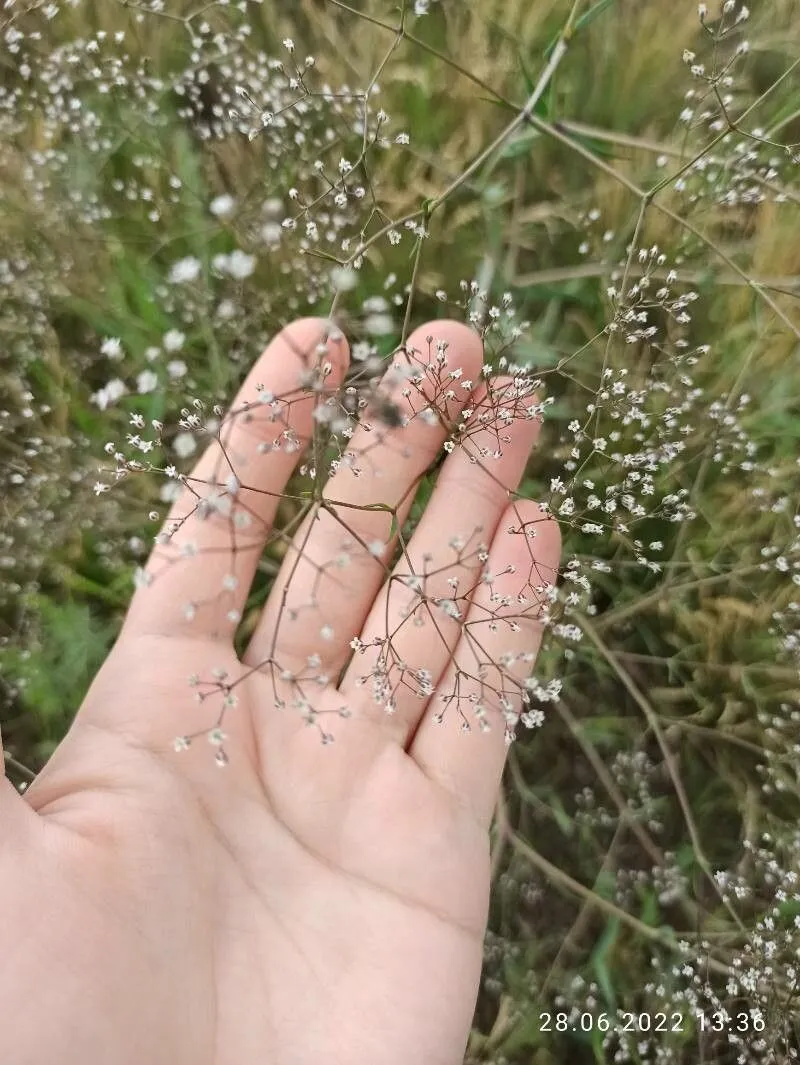
Author: L.
Bibliography: Sp. Pl.: 407 (1753)
Year: 1753
Status: accepted
Rank: species
Genus: Gypsophila
Vegetable: False
Observations: EC. Europe to W. Mongolia
Gypsophila paniculata, commonly known as Baby’s-breath, is a delicate and charming perennial plant that belongs to the Caryophyllaceae family. This attractive species is native to regions extending from Eastern and Central Europe to Western Mongolia. Described by the authority L. in 1753 within the “Sp. Pl.: 407” documentation, Baby’s-breath has since become a beloved plant both in natural settings and cultivated gardens around the world.
The plant is characterized by its slender and branching stems, which can reach a height of around 60 to 100 centimeters. These stems produce an abundance of small, white to pale pink flowers, usually blooming in airy, cloud-like clusters during the summer months. The intricate network of blooms creates an ethereal effect, making Gypsophila paniculata a popular choice for adding a touch of elegance and lightness to floral arrangements and bridal bouquets.
Baby’s-breath thrives in well-drained soils and can often be found growing in meadows, dry slopes, and sandy areas where it enjoys full sun exposure. Despite its delicate appearance, this plant is relatively hardy and can tolerate a range of growing conditions, making it a favored option for gardeners seeking low-maintenance yet visually impactful plants.
Beyond its ornamental use, Gypsophila paniculata also holds ecological significance. It attracts a variety of pollinators, including bees and butterflies, thereby contributing to the health of garden ecosystems. However, it’s important to note that in some regions, particularly North America, it has been labeled an invasive species due to its ability to spread rapidly and outcompete native vegetation.
In summary, Gypsophila paniculata, or Baby’s-breath, is a versatile and enchanting plant that brings lightness and beauty to both wild landscapes and cultivated spaces. Its resilience, coupled with its ornamental appeal, ensures that it continues to be a favorite among gardeners and floral designers alike.
Eng: baby’s breath, baby’s-breath, babysbreath, babysbreath gypsophila, bachelor’s button, perfoliate baby’s breath, tall baby’s-breath, perennial baby’s-breath
Dan: flerårig brudeslør
Lit: muilinė guboja
Deu: rispiges gipskraut, rispiges gipskraut, schleierkraut, scheierkraut, schleierkraut
Fra: brouillard, gypsophile en panicule, oeillet d’amour, gypsophile paniculée
Swe: brudslöja, slöjblomma
Por: cravo-do-amor, gipsofila, mosquitinho
Est: pööris-kipslill
Lav: skarain, skaraina gipsene
Nld: pluimgipskruid
Cym: gypsoffila
En: Baby’s-breath, Tall baby’s-breath, Baby’s breath, Bachelor’s button, BABYSBREATH, Perfoliate baby’sbreath, Babysbreath gypsophila, Perfoliate baby’s breath, Perennial baby’s-breath, Old-fashioned Baby’s-breath, Baby’s breath
Af: Bruidsluier
Az: Süpürgəvari çoğan
Be: Вапнаўка мяцёлчатая
Bg: Метличеста мишорка
Zh: Yuan zhui shi tou hua, 圆锥石头花, 宿根滿天星
Cs: Šater latnatý
Da: Flerårig Brudeslør
Nl: Pluimgipskruid, Bruidssluier
Et: Pööris-kipslill, Pööris-kipslill
Fi: Morsiusharso
Fr: Brouillard, Oeillet d’amour, Gypsophile en panicule, Gypsophile paniculée
De: Scheierkraut, Rispiges Gipskraut, Schleierkraut, Rispiges Gipskraut, Schleierkraut, Rispen-Gipskraut, Schleier-Gipskraut
Hu: Buglyos fátyolvirág
It: Gipsofila comune
Ja: Kogome-nadeshiko
Kk: Ақ қаңбақ
Lv: Skarain, Skaraina gipsene
Lt: Muilinė guboja
Mk: Бело сапунче
Ml: ഗിപ്സോഫില പാനികുലാറ്റ
Fa: نفس کودک
Pl: Łyszczec wiechowaty
Pt: Cravo-do-amor, Gipsofila, Mosquitinho
Ro: Ipcărigea
Ru: Kačim metel’čaty, Perekatipole, Belyj myl’nyj koren, Качим метельчатый
Es: Gipsófila
Sv: Brudslöja, Slöjblomma
Zh-tw: 宿根滿天星
Zh-hant: 圓錐石頭花
Uk: Лещиця волотиста
Cy: Gypsoffila
© copyright of the Board of Trustees of the Royal Botanic Gardens, Kew.
Taken Oct 25, 2019 by Hibiscus (cc-by-sa)
Taken Jan 17, 2020 by Sidney Sidney (cc-by-sa)
Taken Nov 22, 2019 by camille freisz (cc-by-sa)
Taken May 15, 2019 by Adike Gue (cc-by-sa)
Taken Dec 11, 2019 by Maëlys Maëlys Skowron (cc-by-sa)
Taken Jul 8, 2020 by Dieter Albrecht (cc-by-sa)
Taken Jun 16, 2022 by Laszlo Tosoki (cc-by-sa)
Taken Jan 27, 2019 by Giulia Marzia Bordacconi (cc-by-sa)
Taken Oct 17, 2020 by Airos Reivaj (cc-by-sa)
Taken Oct 17, 2020 by Airos Reivaj (cc-by-sa)
Taken Aug 14, 2015 by EOL − Barry Breckling (cc-by-nc-sa)
Taken Jun 28, 2022 by Алена Подольская (cc-by-sa)
Taken Jun 26, 2022 by Stefano Bonello (cc-by-sa)
Taken Jun 17, 2022 by Fabrice Rubio (cc-by-sa)
Taken Jun 24, 2022 by Thibaut Durr (cc-by-sa)
Taken Jun 26, 2022 by Stefano Bonello (cc-by-sa)
Taken Sep 18, 2021 by Exploratorul GOOGLE EARTH (cc-by-sa)
Taken Jul 16, 2019 by Sabina Hartmann (cc-by-sa)
Taken Jun 3, 2020 by Fernández Paula (cc-by-sa)
Taken Nov 3, 2022 by maria roch (cc-by-sa)
Taken Aug 8, 2020 by Julia Vdovczyk (cc-by-sa)
Taken Sep 13, 2020 by Marguerida L. (cc-by-sa)
Taken Aug 12, 2020 by Ermakov Konstantin (cc-by-sa)
Taken Feb 8, 2022 by Philippe Macquet (cc-by-sa)
Taken Jul 26, 2009 by EOL − Václav Dvořák (cc-by-nc)
Taken Jun 16, 2022 by Laszlo Tosoki (cc-by-sa)
Taken Aug 1, 2021 by Jana Vovk (cc-by-sa)
Taken Feb 13, 2021 by Stevens Alana (cc-by-sa)
Taken Dec 29, 2013 by Tela Botanica − Pierre CROUZET (cc-by-sa)
Growth habit>: Forb/herb
Family: Myrtaceae Author: (F.Muell.) K.D.Hill & L.A.S.Johnson Bibliography: Telopea 6: 402 (1995) Year: 1995 Status:…
Family: Rubiaceae Author: Pierre ex A.Froehner Bibliography: Notizbl. Bot. Gart. Berlin-Dahlem 1: 237 (1897) Year:…
Family: Sapindaceae Author: Koidz. Bibliography: J. Coll. Sci. Imp. Univ. Tokyo 32(1): 38 (1911) Year:…
Family: Asteraceae Author: A.Gray Bibliography: Pacif. Railr. Rep.: 107 (1857) Year: 1857 Status: accepted Rank:…
Family: Fabaceae Author: Medik. Bibliography: Vorles. Churpfälz. Phys.-Ökon. Ges. 2: 398 (1787) Year: 1787 Status:…
Family: Aspleniaceae Author: (Cav.) Alston Bibliography: Bull. Misc. Inform. Kew 1932: 309 (1932) Year: 1932…